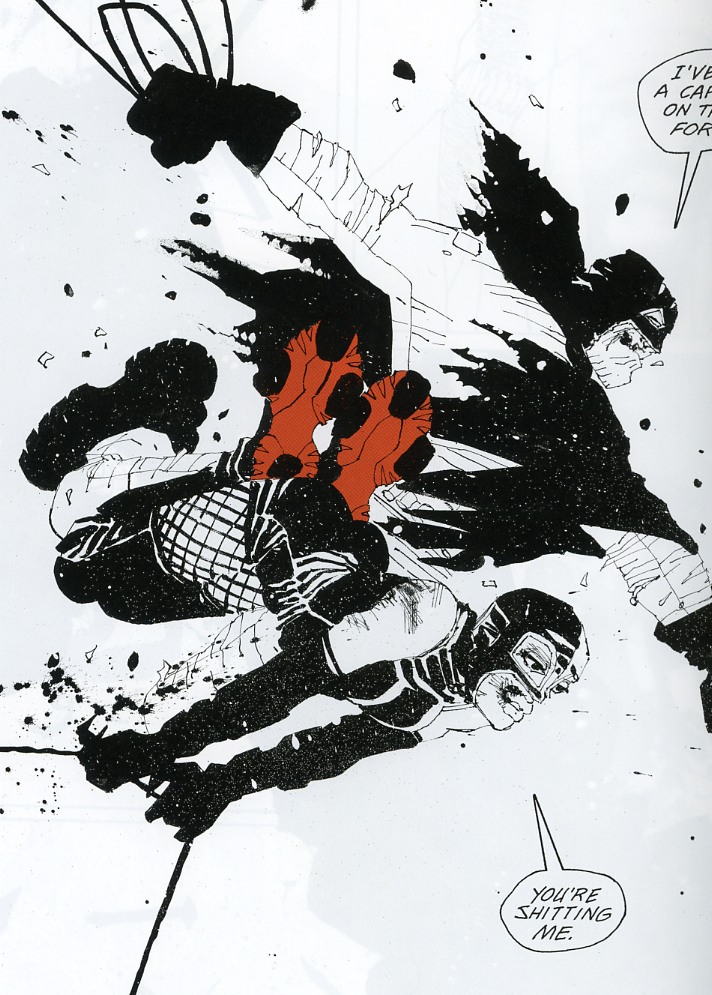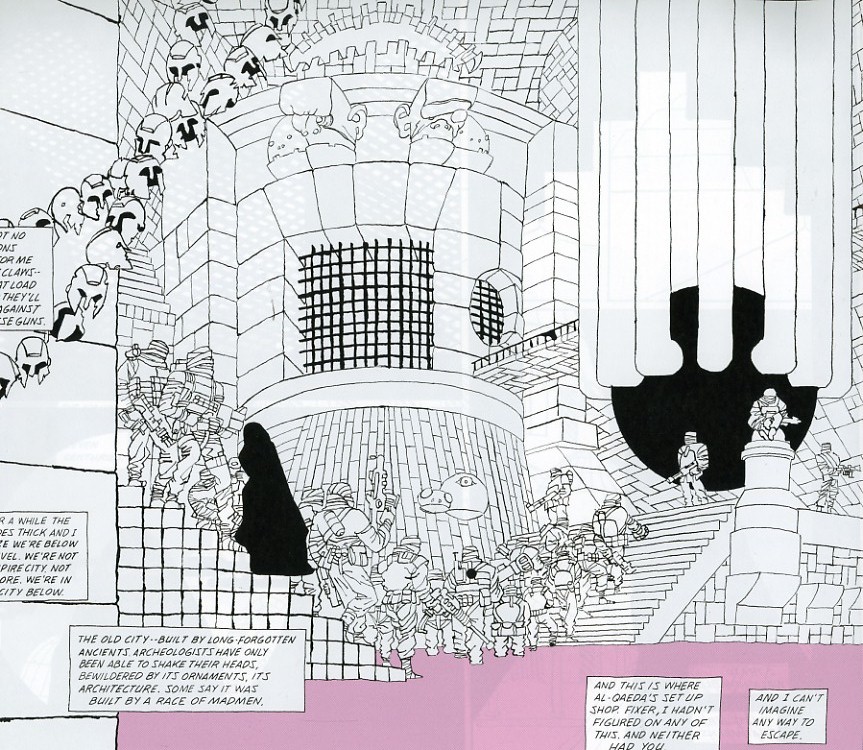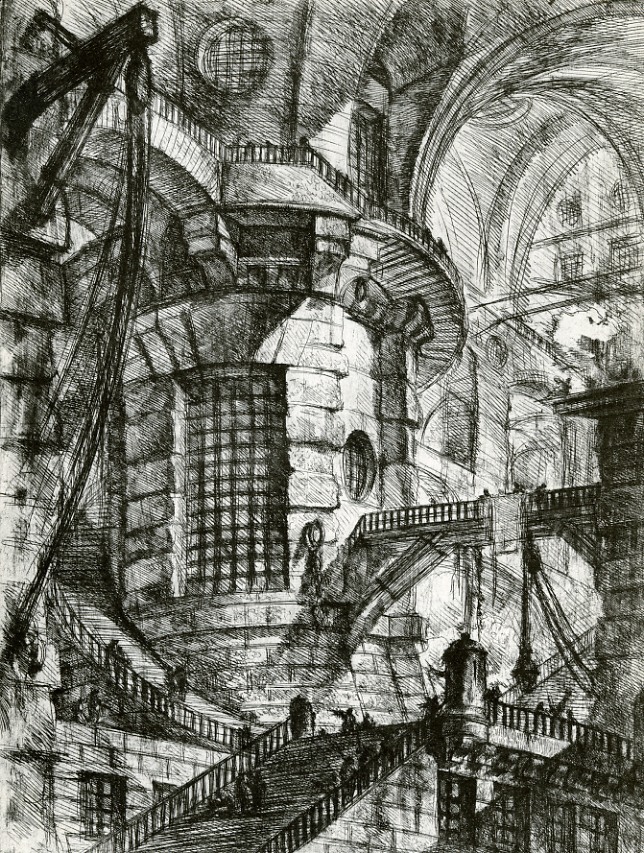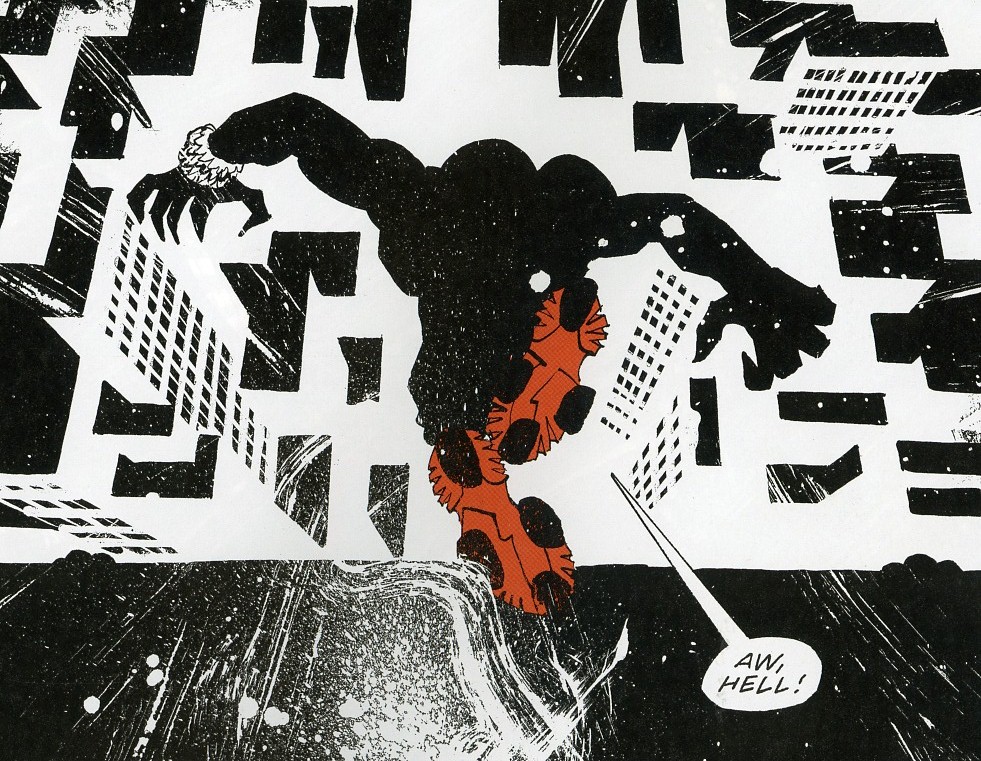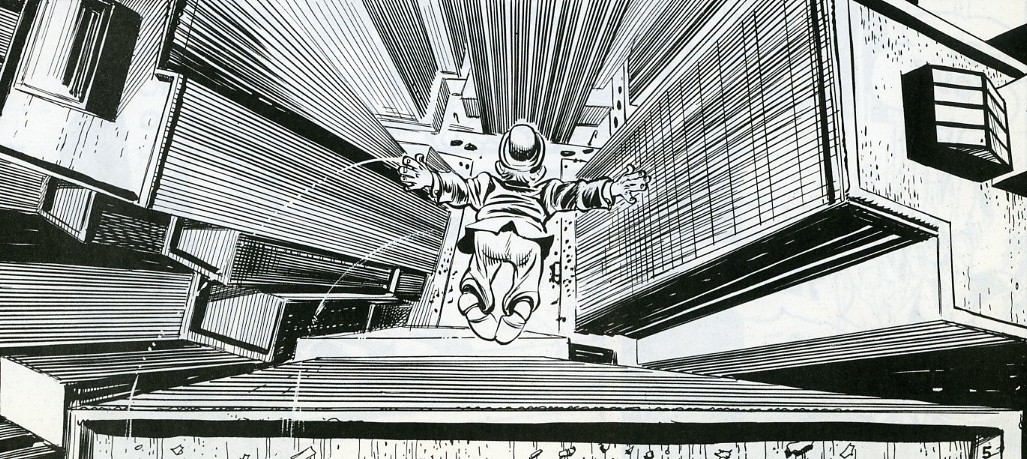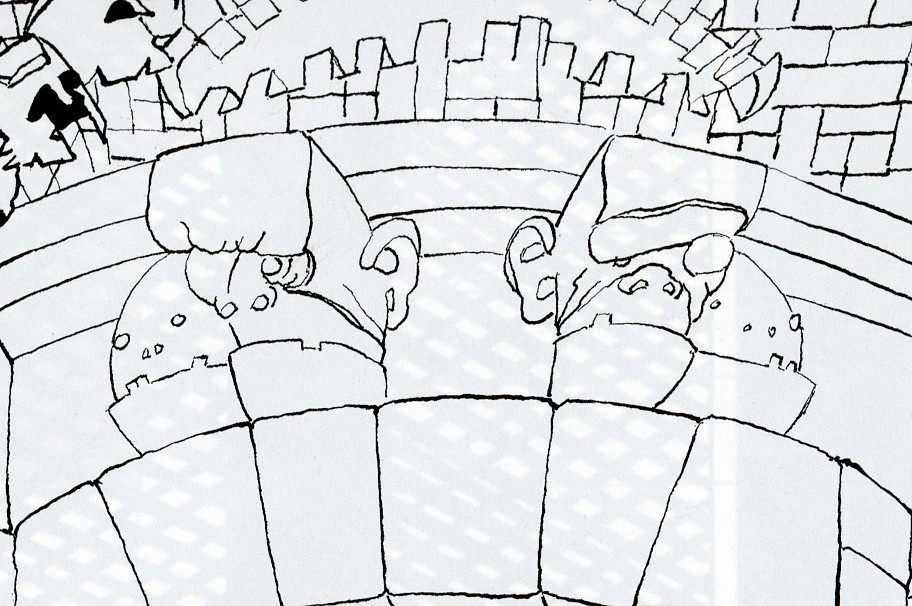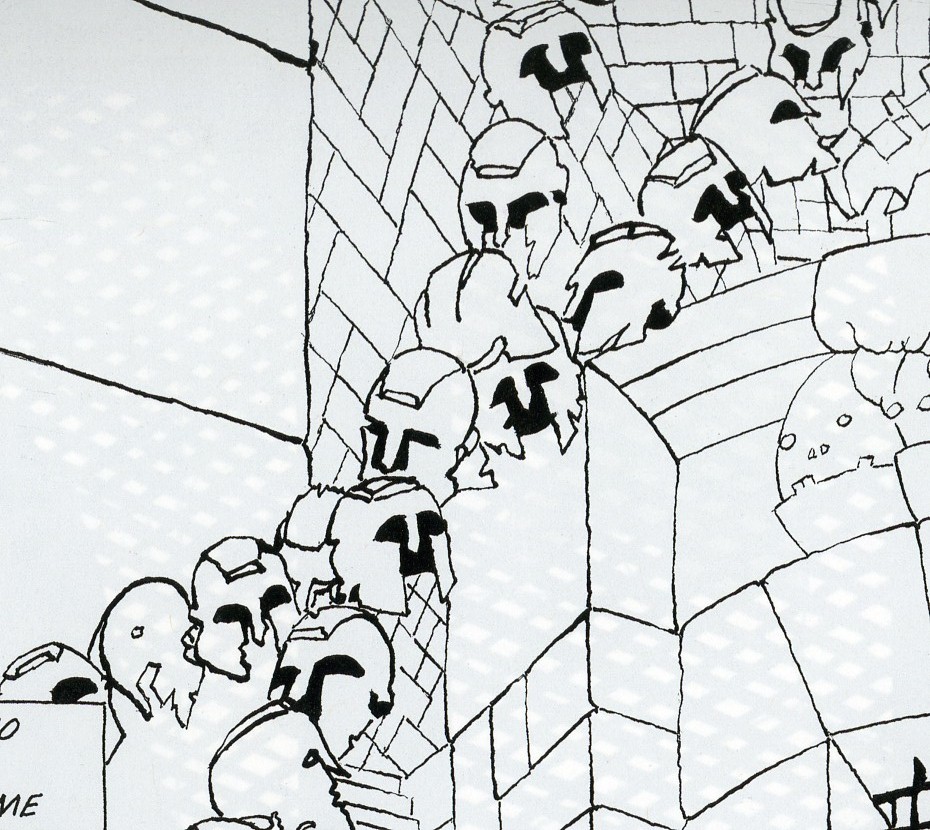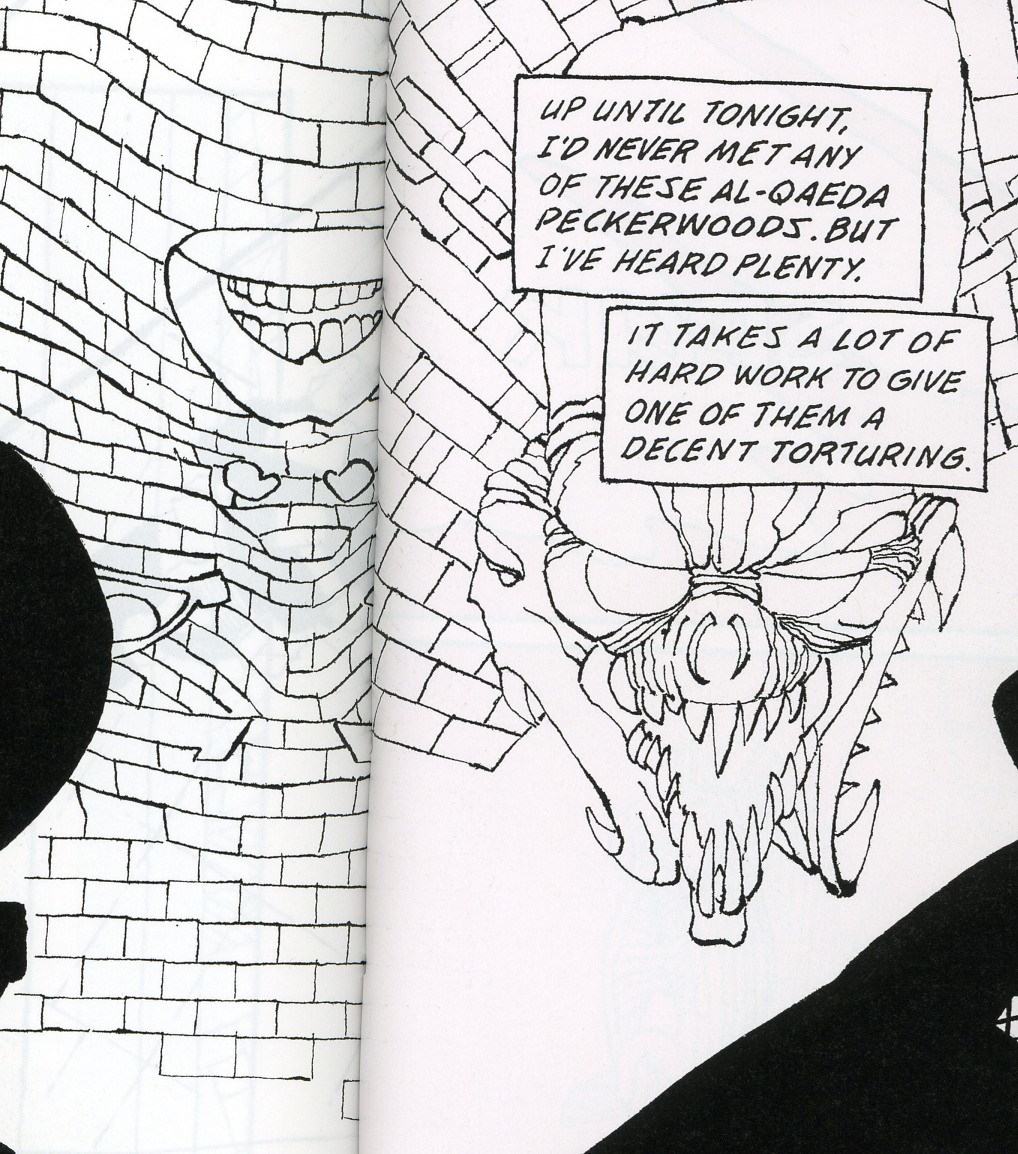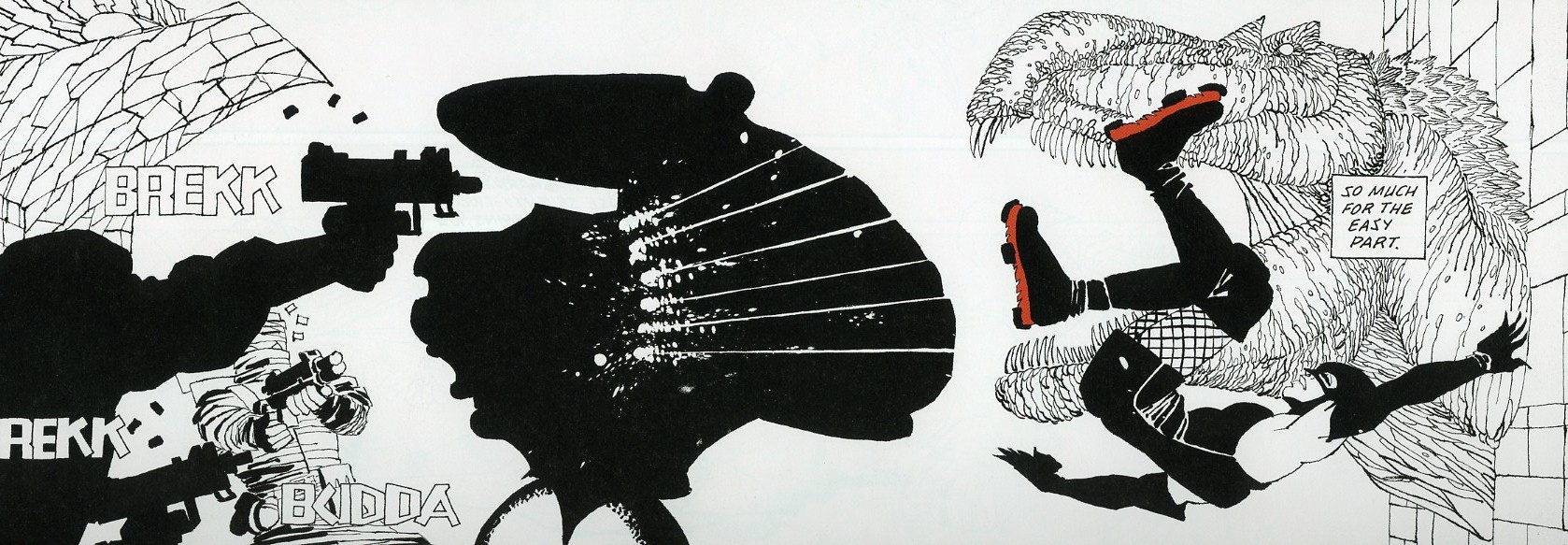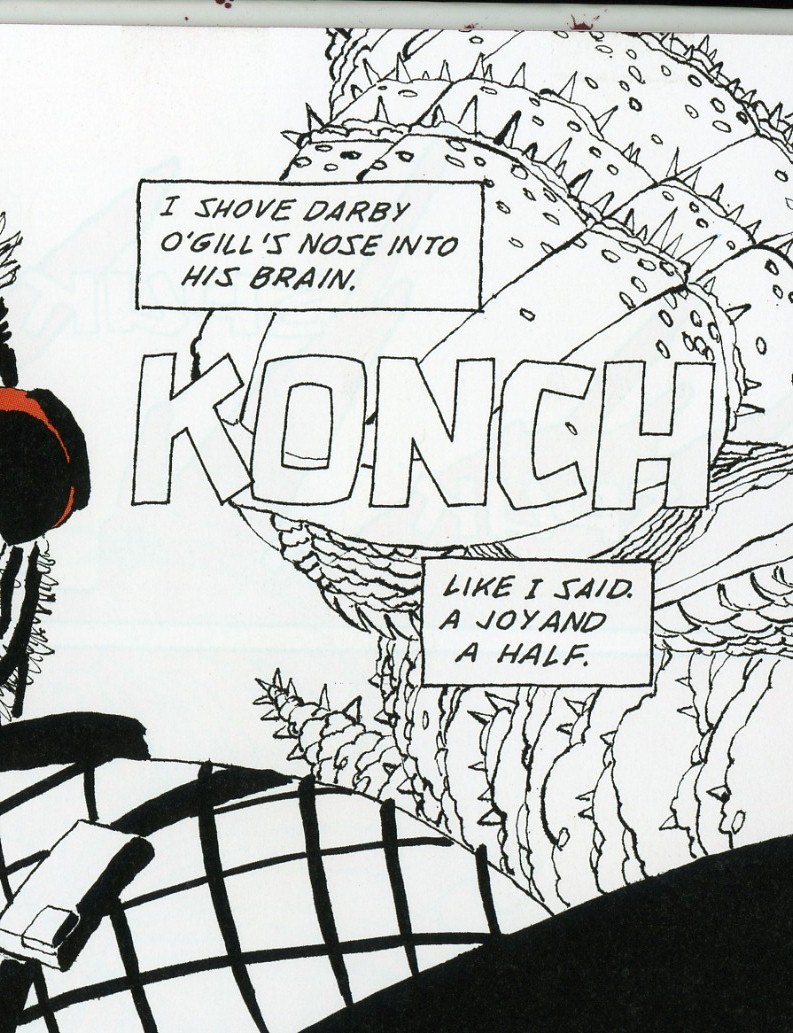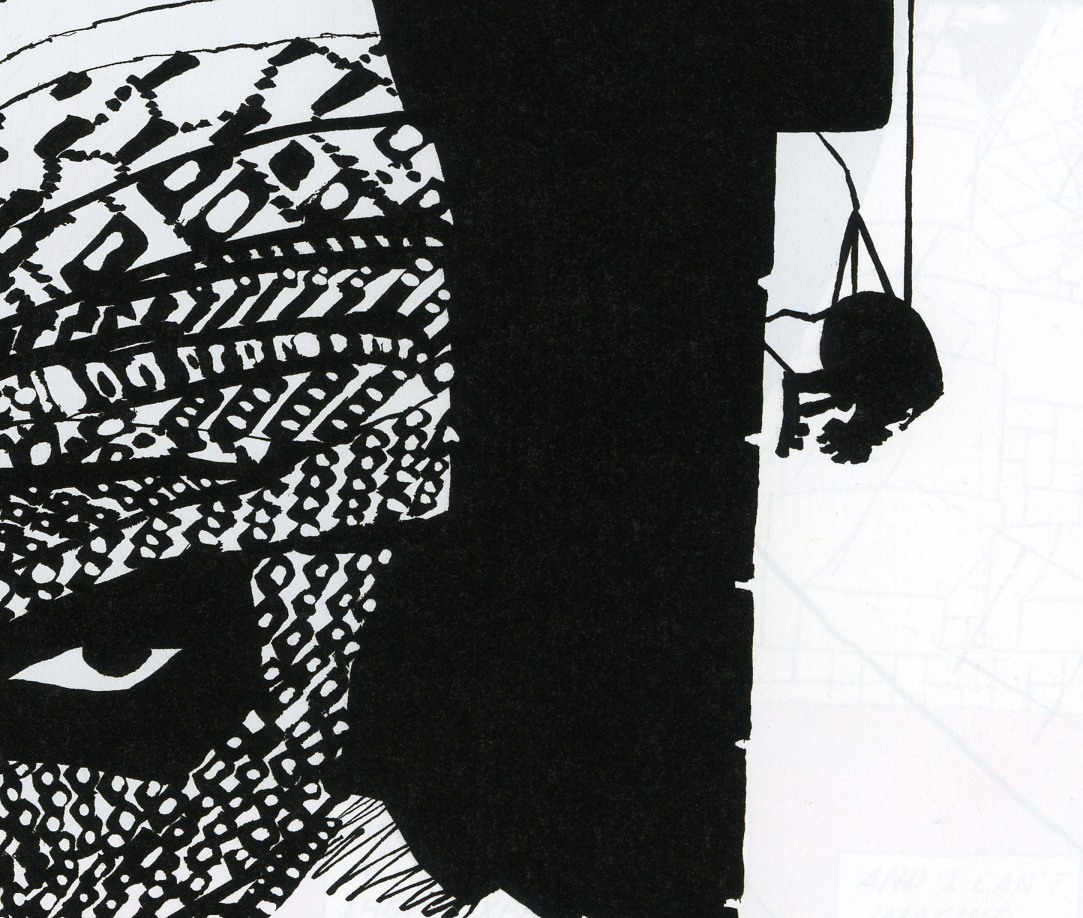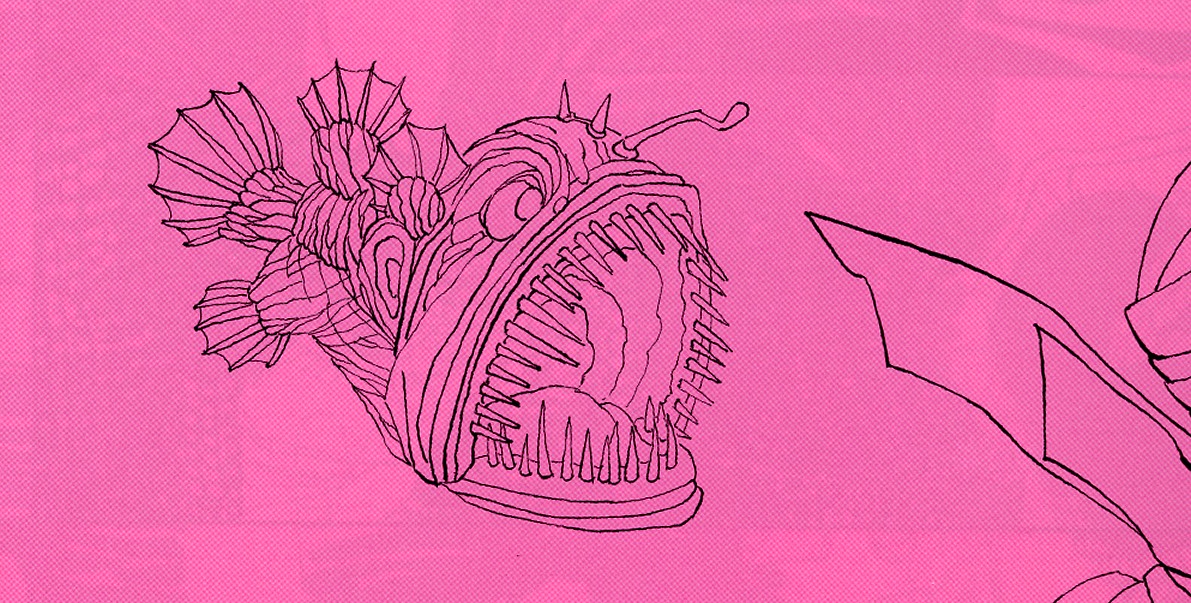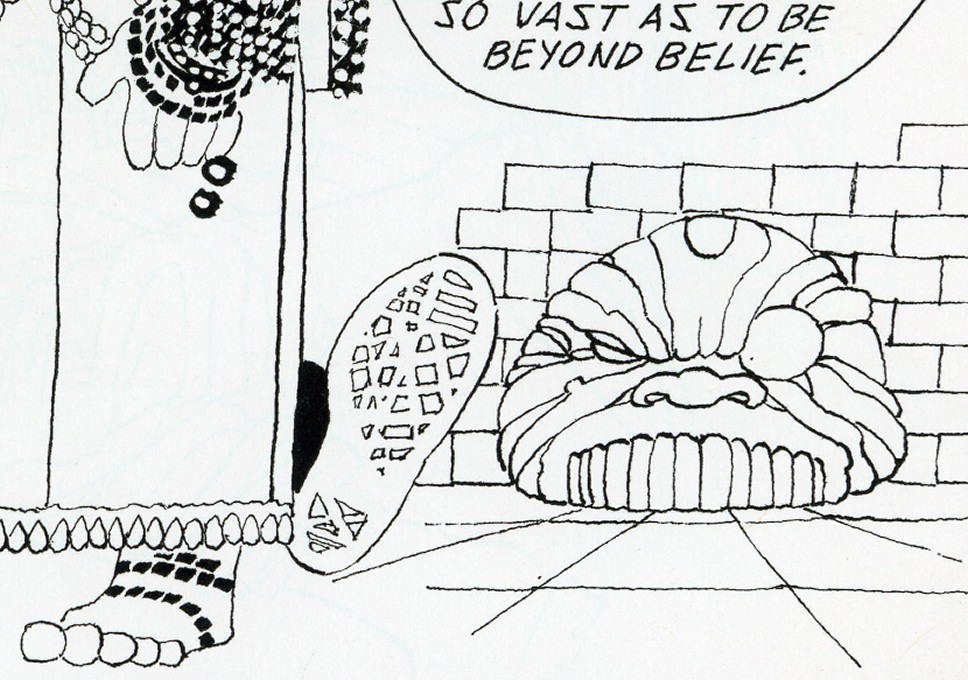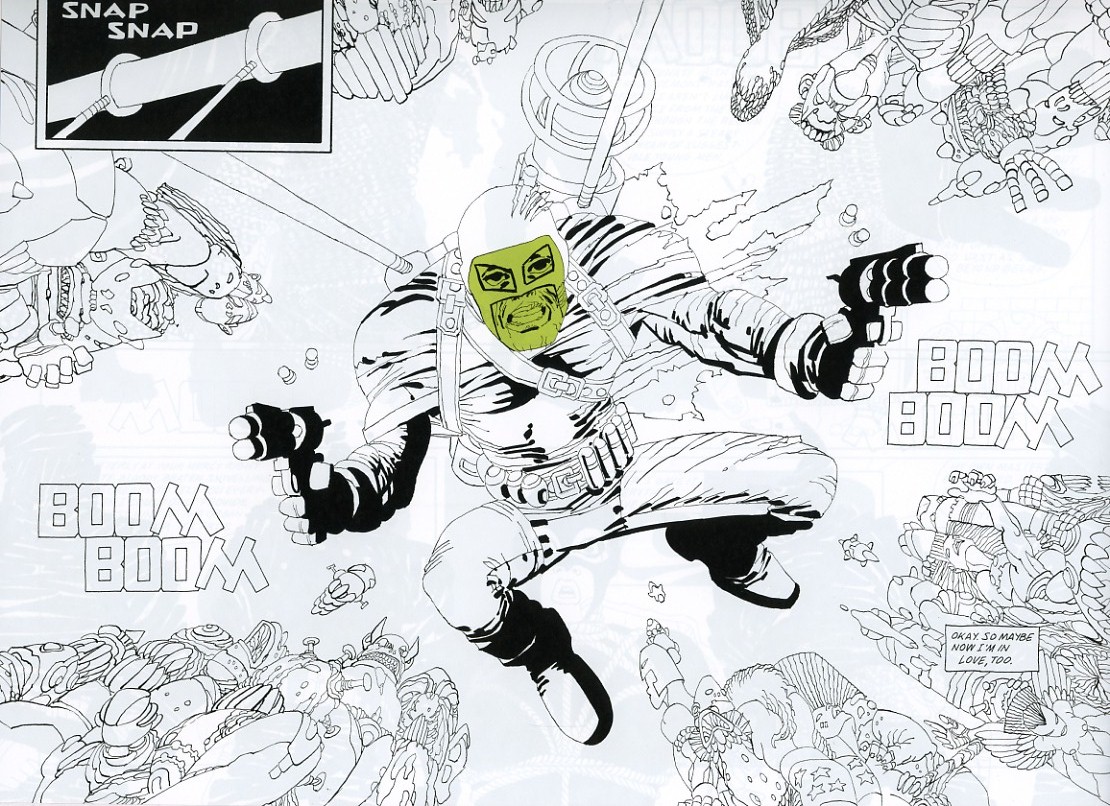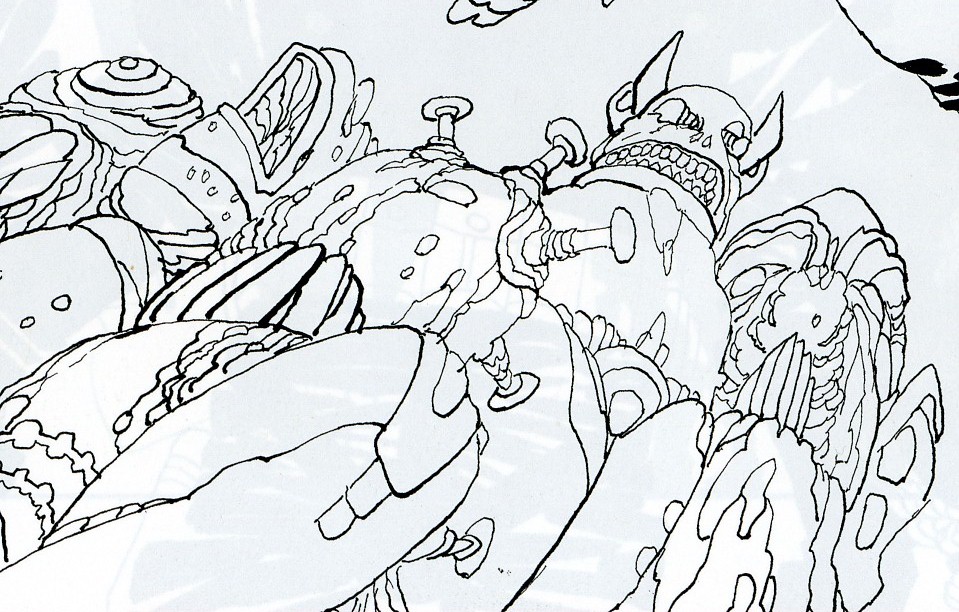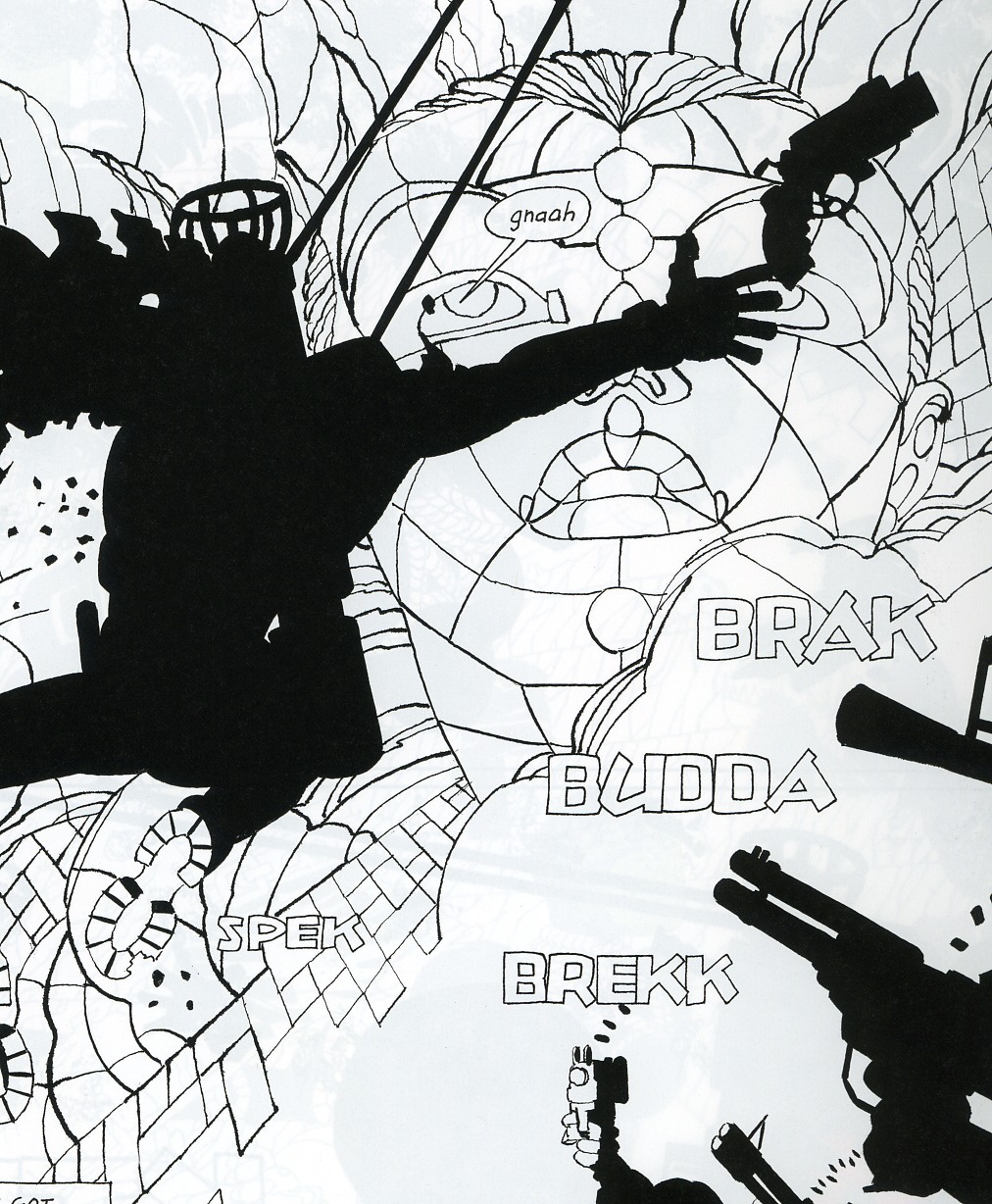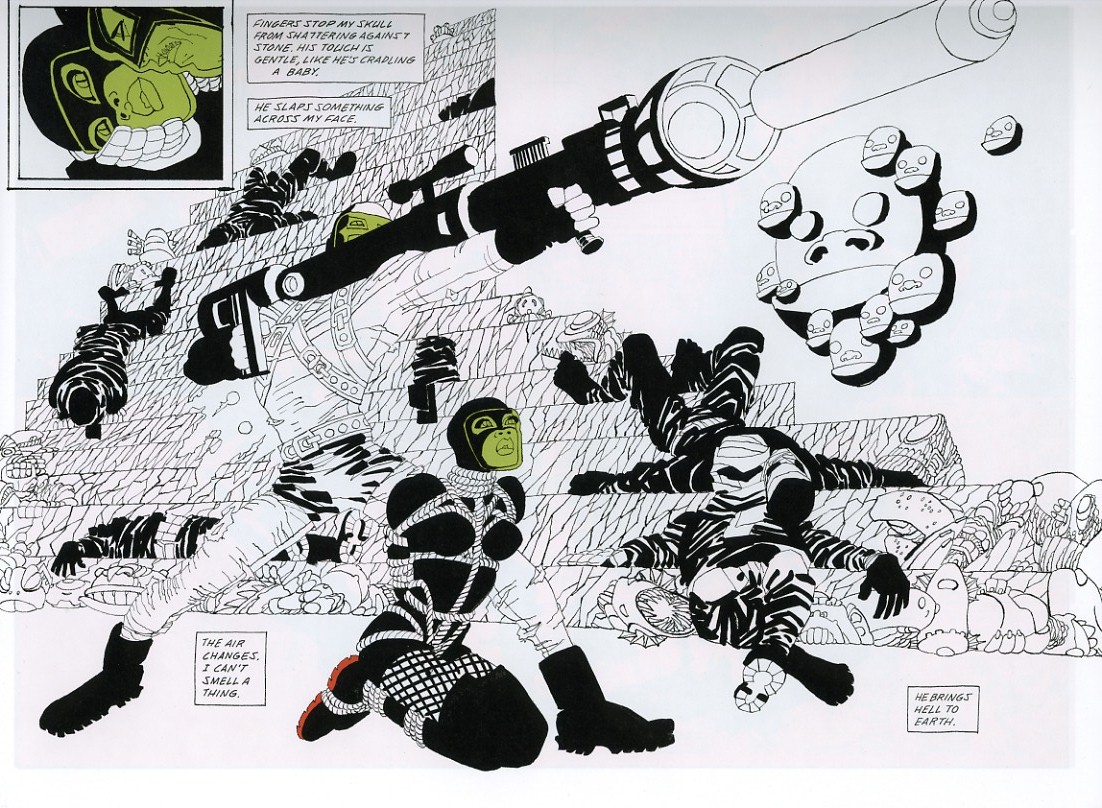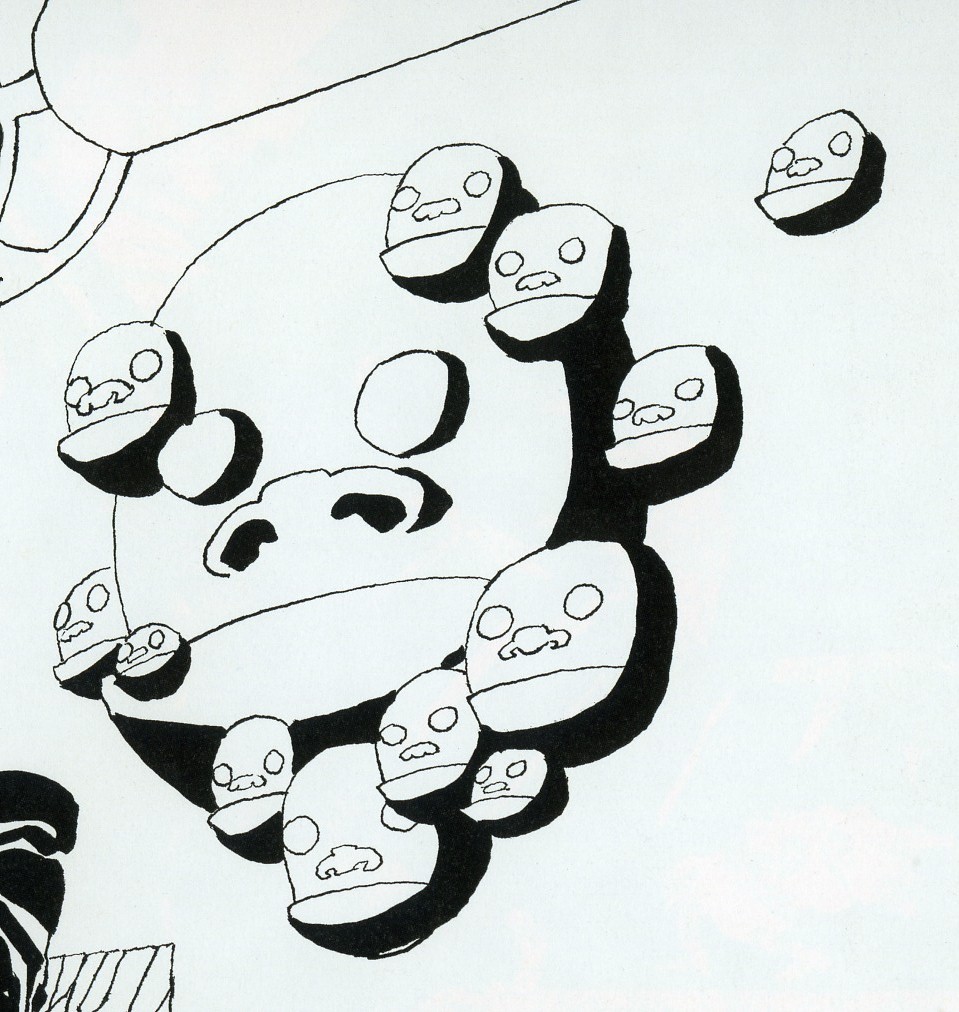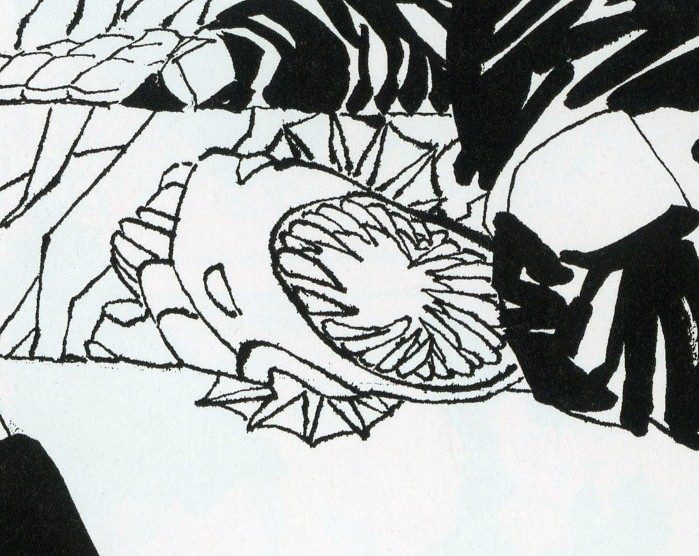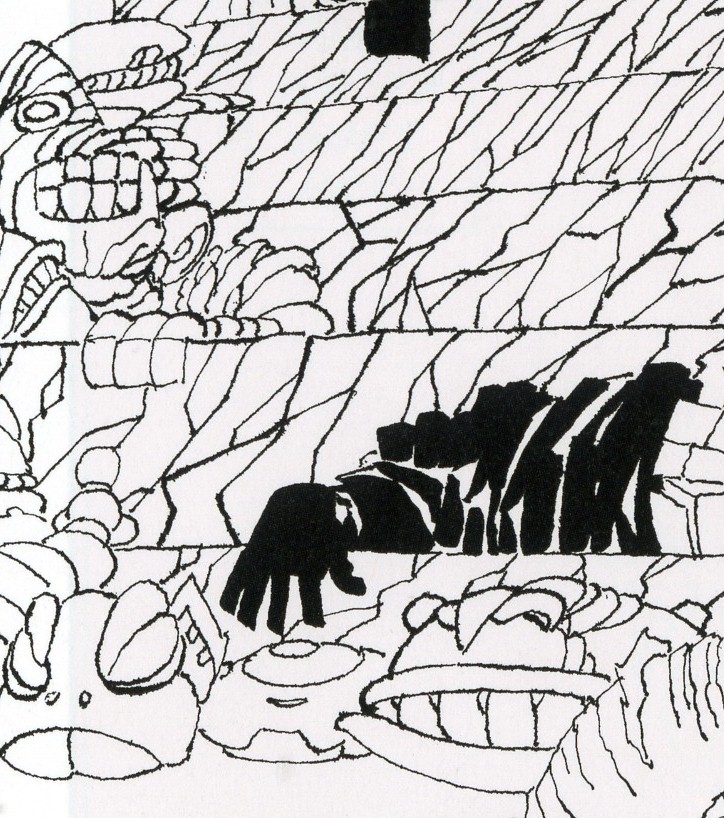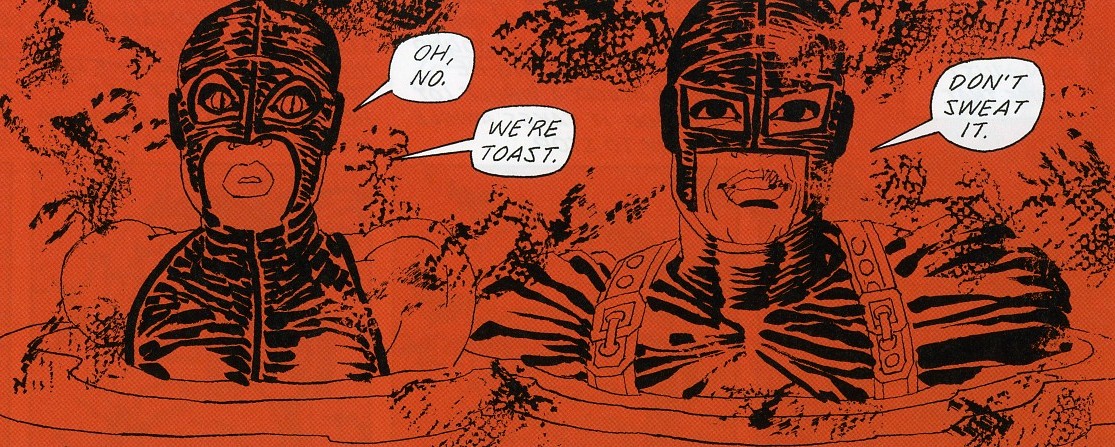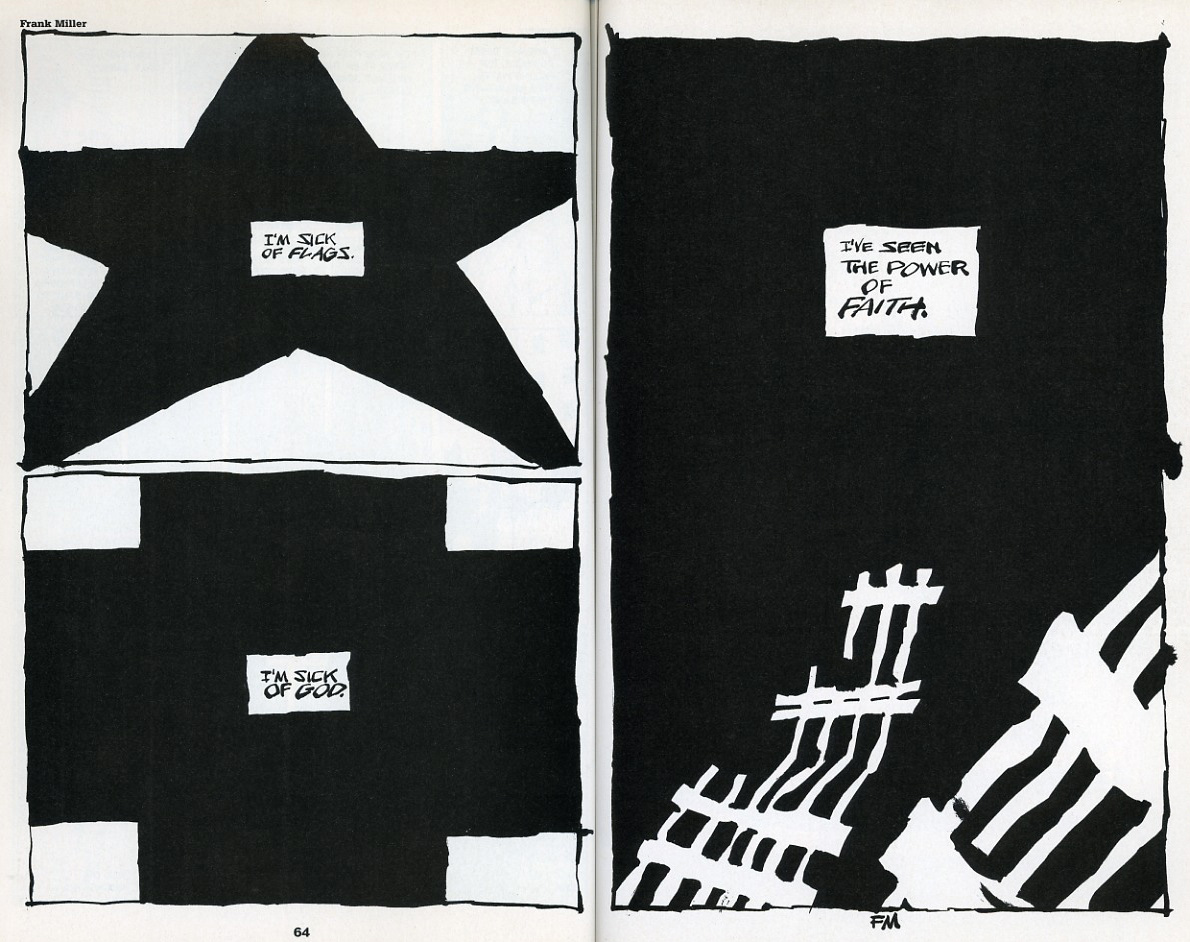Ok, here’s the deal. At Noah’s request I’m publishing here (in blockquotes below) what is largely an unrevised text of a rant I posted on the comixscholars listserv, a rant written as fast as my fingers could type. I would have liked seriously to revise it, but time is, as always, in short supply, and besides Noah says he likes the energy of the original post, so I’ll let it go with just minimal copy-editing and corrections of typos, plus the expansion of a few points I’m not sure were clear enough in the first version.
First, though, I should explain where it came from. When Holy Terror first came out, I didn’t bother to pick it up; no matter how much I’d admired Miller in the past, and how important most of his work from his early run on Daredevil to Batman Year One and Elektra Assassin had been and still is to me, I had been burned too many times since then, especially by the nadir that was The Dark Knight Strikes Again. Nevertheless, I soon found myself in a bookstore, skimming the new book; and though I didn’t purchase it on the spot, it stayed with me, an unscratchable itch to explore it in more depth (it certainly looked better than DKSA—none of those horrid gradients!—or the recent installments of Sin City). I finally gave in, bought it, and meant to review it—but by that time two things had happened: first, consensus had built up online that it was a disastrous career-ender, and hideously paranoid and anti-Muslim to boot; and secondly, Miller posted his notorious blog post fulminating against the Occupy movement, which brought even more contempt rained down upon him. Honestly, at that point I didn’t care about the book so much that I wanted to take the plunge into these muddy waters, and to brave the comment-shitstorm that would have been sure to ensue.
So I decided not to review: yet, even after that decision, I found myself turning back to Holy Terror, and in a strange way my fascination with it grew. And then—and then, two more things happened. A strangely belated discussion about it started a couple of weeks ago on the said comixscholars listserv; and Ken Parille posted a review of the book on the Comics Journal website. Ken’s post was the first I had seen that had something both positive and articulate to say about it (though in the end I didn’t quite agree with him), and that managed to see past its (perceived or real) paranoia and xenophobia to address the substance and artistic achievement of the book itself.
When the thread on comixscholars-l started, I first dipped a toe in with the following remark, appended to a commentary on its supposed “Orientalism” (a question to which I return below):
“Holy Terror” … is an utter mess (and politically abominable, I hasten to add, to shore up my bien-pensant credentials) but in a way kind of a fascinating one. I keep meaning to write about it somewhere.
Ken then chimed in to say he agreed with me, and linked to his TCJ review. However, while I had called it “an utter mess” he discussed it there in terms that made it seem much more conventionally successful: “It’s a fascinating hard-boiled love story, an attractively designed romance set against the backdrop of a post-9/11 America in which love is a disease… Holy Terror’s artistry triumphs over its political will.” He also ended up giving it an A—higher than Habibi, Carnet de Voyage, and Asterios Polyp (relative judgments with which, I should add, I don’t disagree). When the discrepancy between his and my verdicts was pointed out, he explained that he found it a mess ideologically, but successful artistically. This was the immediate cause for my rant, which, none too soon, follows (images added for the sake of clarification):
Now I’m wondering if we read the same book… :) As I said, I do find it fascinating–and I’ll get to that in a second–but it is a mess far beyond just its ideological message. To begin with, the plotting is so rudimentary as not even to deserve to be termed “plotting.” Notice how the book is divided exactly in half, presumably originally for publication in two installments, but also corresponding to the two periods in which Miller is supposed to have worked on it, and easily distinguishable from each other by the utterly different inking treatment (first half, splashy; second half, mostly linework and large areas of solid black). So. First half: Not-Batman chases Not-Catwoman across the rooftops of Not-Gotham City. They fight. They have sex. Bomb explodes. Nail ends up in Not-Catwoman’s leg. It hurts. It really hurts. It really REALLY hurts. We hear about it for pages on end. Flashback to suicide bomber. Same bomb explodes again–NAILS! The city lies in ruins. Not-B and Not-C swear revenge. As does Not-Commissioner Gordon.
[Note: I borrowed the “Not-Batman” and “Not-Catwoman” coinage from other reviews I had seen across the web. Indeed, soon after writing the original rant, I googled the two terms, and found a review that contained a sentence extremely close to the one right before this note, including the term “Not-Gotham.” I honestly don’t think I had read that review previously, and maybe it was just a case of serendipity, but I may also have indeed read it, and forgotten all but that one phrase that remained stuck somewhere in the back of my mind. To the writer of said review: apologies for my unintentional borrowing.]Second half (interspersed with montages of terrorists and various US and international political and public figures): Not-B and Not-C (who has quickly gotten over her wound–and, by the way, may I ask why she’s supposed to be wearing Christian Louboutin sneakers?) swing over the rooftops.
They kill some bad guys, capture one and torture him… He talks and then they blow him up. Meanwhile a Muslim woman is being stoned and Americans are watching “Transformers.” More bombs–Not-Statue of Liberty is blown up. Ex-Mossad agent, whom we know is Israeli because he has the Star of David tattooed on his face (always a good choice, tattooing your country’s flag on your face when you’re trying to be a spy) tells them about the Not-Gotham City mosque, center of terrorism. Bizarre undeveloped subplot about Not-B falling in love with Not-C. Generic Muslim man beating up his wife. Not-C goes into the mosque. Is captured and taken to the leader of the terrorists who turns out to be, umm, Irish? They want to kill her, Not-B swings in and blows their heads off, big scary bomb explodes but somehow they manage to get out. Six weeks later: Not-Commissioner Gordon is shivering in his bed. “No wonder we call it terror.” The end.
There is no narrative arc, no suspense, no attempt to develop the characters beyond the purely convenient labels of their names. All of these things Miller would have been able to do quite masterfully back in the Daredevil or DKR days, but by now any hints in such directions have become nothing but narrative tics, empty gestures. Maybe Batman telling Catwoman that he is falling in love with her might have meant something–a tiny tiny something–if those had been the actual characters speaking, with decades of history behind them, but replacing them with Not-Batman and Not-Catwoman, simple place-holders undeveloped in any way beyond simply being not-the-characters they had started off as being, reveals how whatever romantic punch this narrative element was supposed to carry would have been totally unearned, as it relied *entirely* on the readers’ previous knowledge of the characters. Same goes for Not-B’s constant reference to “my city.” If this had been Batman speaking, ok, it might have resonated with Miller’s earlier work–but since it’s not, it again reveals Miller’s reliance upon shorthand and the readers’ previous emotional cathexes, and it comes off as–I don’t know how to put it exactly, but not plotting, simply the emotional exploitation of stereotypes stored in fans’ psyches.
Then there are all the narrative tricks which, once again, seem like foggy reminiscences of when Miller knew how to tell a story: the thought-captions in the first section come directly from DKR, but, again, seem blank, just storytelling tics that carry none of the psychological weight that they carried two and a half decades ago…
So, what do we have instead? Things happen, done by blank characters who are brought on stage for the sole purpose of enacting a revenge fantasy. For that reason, I suppose, they need have no more personality than figures in a masturbatory, erotic fantasy need have one. The plot again (shorter version): Terrorists do bad things to us. We kill them. The end.
That’s also why, I should add, I was saying there is little actual “Orientalism” in there: the bad guys are as much blank placeholders as the good guys. There is none of the Orientalist texture of, say, “300.” Everything is just… empty.
Further issues with the storytelling? How about the strange crosscutting, in the second half, between Not-B and Not-C’s doings, and the montages of characters from Bush and Cheney to Obama? Is this happening in one night or over a decade? I suppose a sympathetic reading might make one of those strands extra-diegetical, as if the book reflects both the time of its story (one night) and the time of its making (ten years)–but, if so, I don’t particularly see that as intentional on Miller’s part.[Note: on second thought, maybe it is, or maybe the book itself knows, and says, things more clearly than its author might.]
Ok, the positive (not yet the fascinating): yes, there is all the narrative energy in the first half, a mastery of dynamic art, etc.–everything that Ken pointed out–but, while not as bleached out as the narrative tics I was talking about, it still reads like Miller on auto-pilot. All the splashed ink and white-out in the first half seem like an attempt to go in the direction of more “artsy,” painterly artists such as Sienkiewicz or McKean, and it’s fine, well-done, but again, to me not earth-shattering in any way.
I actually like the second half much better, which does away with such painterly tricks (and which has been criticized, as a consequence, as Miller forgetting how to draw or not giving a damn anymore). And here we are getting to the fascinating part–because, well–there’s that snail. Huh? In the panel of Not-C deciding to go into the mosque, there is a beautifully drawn, purely built out of uninflected lines, snail–a giant snail, obviously, given the perspective of the drawing:
It is in no way given a narrative reason for being there. It just is. At this point, Miller enters a mode of strange narrative excess, going well beyond the requirements of the story–and he continues with it, the snail is not just a one-off. Look at the large, almost page-sized panel of the tower-like structure underground:
First of all, it’s important to realize it’s a swipe–from one of Piranesi’s “Carceri” (Miller at least gets points for creativity in swiping)–specifically this one:
Now, interestingly, this is not the first time that Piranesi has been swiped in comics recently–see the cover of the Act-I-Vate primer–but this is a much more, shall we call it, original kind of swiping. It’s also a much more interesting swiping than the one he practices in the first half of the book, where this panel of Not-C leaping off a building:
is clearly intended to evoke this famous image from “The Story of Gerhard Shnobble,” by Miller’s hero, Will Eisner:
The swipe from Eisner is clear fan-service, intended to give the thrill of recognition to the literate comics reader, and to help Miller claim for himself, one more time, Eisner’s mantle. I don’t think any such kind of knowing reference and recognition is intended with the Piranesi borrowing—it is not an homage, but neither is it done out of laziness or for simple convenience. The image is transformed, worked over too much for that to be the case. Look at the brackets holding up the tower’s cornice: In Miller, they have been replaced by symmetrical pairs of faces–one Gahan Wilson-like, the other best described as Humpty-Dumpty-as-dying-Vader:
Again, what??? Then there are the strange ovoid faces toward the bottom of the tower:
and the double garland of Spartan helmets festooned across the upper left corner of the panel:
Miller makes a gesture toward explanation in a caption (“The old city–built by long forgotten ancients. Archaeologists have only been able to shake their heads, bewildered by its ornaments. Some say it was built by a race of madmen”)–and, if in the context of the book, that seems like just a convenient excuse to doodle whatever he feels like in the images, it’s also strangely self-referential: yes, we too can only shake our heads, bewildered by the book’s ornaments which are completely unrelated to the book’s overt message. “A race of madmen”–and we almost feel that Miller’s gone nuts.
Then–then there are the strange Cheshire cat grins on the brick walls:
the gargoyles and dinosaurs sticking their heads out:
the strange silhouetted ball-with–feet-and-hands rappelling down the wall behind one of the terrorists:
There’s the deep-ocean angler fish in the few feet of water into which Not-C jumps:
There’s the monocled Erich-von-Stroheim-in-The-Grand-Illusion half-face on the ground, behind the short veiled “highly-verbal” Persian-looking guy:
There are the Pop accumulations of figures, including a woman, from the back, in star-spangled hotpants and some kind of viking-monster, in the panel where Not-B leaps in:
There is the monumental statue of Buddha (recalling Bamiyam? But again, why? If the Taliban blew it up there, why would Al Qaeda live with it here?) behind a sound effect of–har har–“Budda”:
There are all those accumulated faces and grins behind Not-B when he fires his bazooka thing:
… and so on.
There is, overall, a strange, unsettling kind of image excess over the requirements of the story. It’s as if Miller couldn’t stay faithful to his ideological convictions, or even his hatred of terrorists, and began doodling. Is it some kind of Baroque horror vacui, or–more appropriately, perhaps–some kind of outsider art horror vacui? At times, and mutatis mutandis, it almost reminds me of Rory Hayes. I like how at this point Miller’s mastery fails: the slick paintwork of the first half gives way to the red-background two-panel of Not-B and Not-C waiting for the bomb to explode, that looks so awkward, almost untaught, as to completely negate the slickness of the first half:
It’s a mad, bizarre book. I had hated Dark Knight Strikes Back, thinking Miller had gone crazy, but now I realize it’s just that he had not gone crazy enough. I have no idea where he can go next–but there is a strange breakthrough here (maybe with no exit, with nowhere to go) that is more interesting than any other comic I’ve read this year, and hinting at a kind of artistic madness that most artcomics can only aim toward, but not quite reach.
Whew. I’ll stop here.
And stop I did. After my rant, in response to a post by Charles Hatfield who declared himself so morally outraged by the book and by my discussion of it that he refused to engage it critically formally (even seemed to see it as immoral for anyone to do so), I responded:
Hey, Ken’s response to Holy Terror was much more positive than mine! Why is it mine that warrants this rant?
I’d be happy to explain, at length, what Miller’s work has meant to me over the last two and a half decades–in view of which, at least, he still does warrant my critical attention, whatever his current political positions. I’d also be happy to get into a discussion whether any artist’s political positions that you (or I, for that matter) may disagree with are enough to put their work beyond the pale of critical discussion (Ditko, anyone? T.S. Eliot? Ezra Pound? Seurat, for that matter, who had clear left-anarchist associations? Where do we draw the line?). But I’ll just say that I was addressing the work, not the man, and the work definitely does warrant such critical attention. And given that the work is intended to convey a certain political position, and that many of the elements I discussed actually end up undermining, deconstructing in some way, that position, I’d say it is exactly analyzing it in such “art terms” that can provide a constructive critical, and even political, perspective on the book.
(I’m quoting my response to provide some shield, some defense against similar critiques that may be raised. And, ok, maybe I’m being paranoid too, in a different way.)
If I were to expand this and properly re-write it, I would emphasize further the strange self-consciousness of the book that I hinted at on one or two occasions: the apparently braided diegetic and non-diegetic strands (the only way it seems to me the book’s temporal contradictions can be resolved) and the comment about “the race of madmen.” Holy Terror feels like a strangely self-knowing book, but one that in the same gesture paradoxically foregrounds the lack of self-reflection on the part of the artist, the contradiction between the resulting work and its intended ideological functioning. I would also tone down my criticism of the rudimentary plot: it more and more seems to me that Miller’s abandonment of the (genre-based, admittedly, I say to preempt any griping) narrative sophistication of his ‘80s work is fully intentional; and the fascinating bizarreries I point out here would have been impossible had such sophistication not been abandoned. I would also compare the book to Miller’s contribution to 9/11: Artists Respond, which refreshingly rejected any and all ideologies:
(Homework assignment: what happened?)
Also, as I’ve been thinking a lot about Kirby lately, I can’t help but feel that the rhetoric of visual excess I use here to discuss Holy Terror is not all that different from what I and others have said to defend the King’s work of the seventies and after. I don’t know if that constitutes some kind of redemption for Miller; I don’t know if connecting the two in such a way is at all legitimate (I am only referring to my own rhetoric, which I do know is strangely similar)—but I know for a fact that my just bringing up the notion is sure to prompt yet another, additional, shitstorm in the comments. (James? Charles?) Have at it, all.
__________________
Editor’s note: Andrei writes more on Frank Miller at his own blog here.

